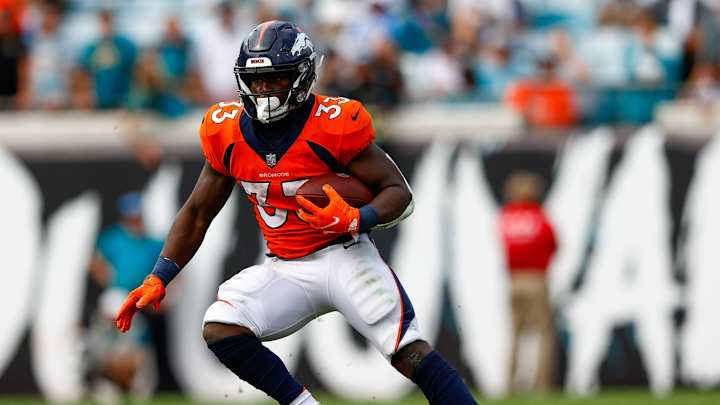Broncos Player Profile: Javonte Williams #33 | Running Back

In this story:
In the 2021 NFL draft, Denver Broncos GM George Paton made a move to trade up and get running back Javonte Williams out of UNC. It was a move that garnered some backlash, not because Williams is a bad player, but because running backs have a lower value in the modern NFL.
Running back is the position with the shortest longevity as it takes such punishment consistently, but Williams had a great rookie year and seems ready to take a step forward for this season.
However, there are areas of concern that he has to improve upon. So when looking at the complete picture, what can Williams offer for 2022 and even beyond? Let's dive into his resume to find the answer.
Biography
Williams is still a young player who just turned 22 years old. That bodes well, as the age of concern for running backs is from age-28 to 30. He was born and raised in North Carolina, and UNC was the only FBS school to give him an offer.
College Career
In his first year in college, Williams had 43 carries for 224 yards. He added five touchdowns, which he matched in Year 2 on 165 carries. That second year saw him pick up 937 yards, but he also fumbled the ball twice.
During those first two years, he added 25 catches on 28 targets for 234 yards receiving. Williams was part of a rotation at UNC, and he was able to stand out his first two years.
Year 3 saw him take a giant leap forward with his play, mainly with his efficiency. He had 157 carries and nearly hit 1,200 rushing yards, coming 32 yards short. He added another fumble but scored 19 touchdowns and forced 76 missed tackles.
Williams was challenging to tackle, and he paired exceptionally well with Michael Carter, who was later drafted by the New York Jets in the same 2021 class. Williams was big and physical and often imposed his will on would-be tacklers and in pass protection.
There were a couple of concerns with Williams revolving around his vision and play as a receiver. The main issue as a receiver was some bad drops on his end, though he only tallied four throughout his collegiate career.
Draft
While Williams was part of the top-three in the 2021 draft class at running back, his placement carried. Najee Harris and Travis Etienne were promising prospects, and draft analysts ranked them differently and both were selected ahead of Williams. But, for some, Williams was the top running back and only helped himself through the draft process.
Outside of his 40-yard dash, Williams was above the 70th percentile in each test. His 40 time put him in the 47th percentile, along with his 20-yard split, while his 10-yard split was in the 41st percentile. In the end, he earned an 8.79 relative athletic score.
Paton liked what he saw in Williams and traded the 40th and 114th overall picks to Atlanta to move up and draft Williams with the 35th overall pick while also getting the 219th overall pick back.
Professional Career
While Williams had to compete to earn his spot as the primary backup to Melvin Gordon, he won the No. 2 job and had an impressive rookie year, though not without issues.
Williams picked up 903 rushing yards on 203 carries with four touchdowns, two fumbles, and 63 missed tackles forced. Williams added 43 catches on 51 targets for 316 yards as a receiver, but he dropped four of those targets.
Drops are a concern with Williams. While they aren't large numbers, per se, it was an 8.5 drop percentage, the seventh-highest among running backs. Now, drops will happen, but running backs are the safety outlet, so you want to cut down the percentage of drops.
Vision as a runner was also a concern with Williams, but he could make up for it with his power as a rusher. On multiple occasions, he would run into the heart of the defense and have an unsuccessful run rate.
In fact, Williams was one of the most boom-or-bust running backs in the NFL, with 114 of his 203 rushes going for three yards or fewer. His success rate was 46.3%, while the league average was 49.1%, so not significantly lower but something to still work on.
Again, Williams' ability to force missed tackles was a huge benefit to help cover the issues he had with his vision. He forced the second most in the NFL, behind Indianapolis rushing champion Jonathan Taylor, who forced 66 missed tackles. However, to get those three more forced missed tackles, Taylor had 129 more carries than Williams.
2022 Outlook
While Williams and Gordon are expected to have a similar usage to last year, where both ended with 203 carries, there is likely to be a slight change. Instead of Gordon being the 1A, Williams seems to be taking that over, and the balance of carries is headed towards more for a 60/40 split favoring the younger guy.
The Broncos' new scheme, which relies on vision, is causing some concern. However, the comments coming out through the few training camp practices are promising.
Head coach Nathaniel Hackett wants the running backs to be heavily involved in the offense. That means Williams has to step up as a runner and as a receiver.
Follow Erick on Twitter @ErickTrickel.
Follow Mile High Huddle on Twitter and Facebook.
Subscribe to Mile High Huddle on YouTube for daily Broncos live-stream podcasts!

Erick Trickel is the Senior Draft Analyst for Mile High Huddle, has covered the Denver Broncos, NFL, and NFL Draft for the site since 2014.
Follow ErickTrickel